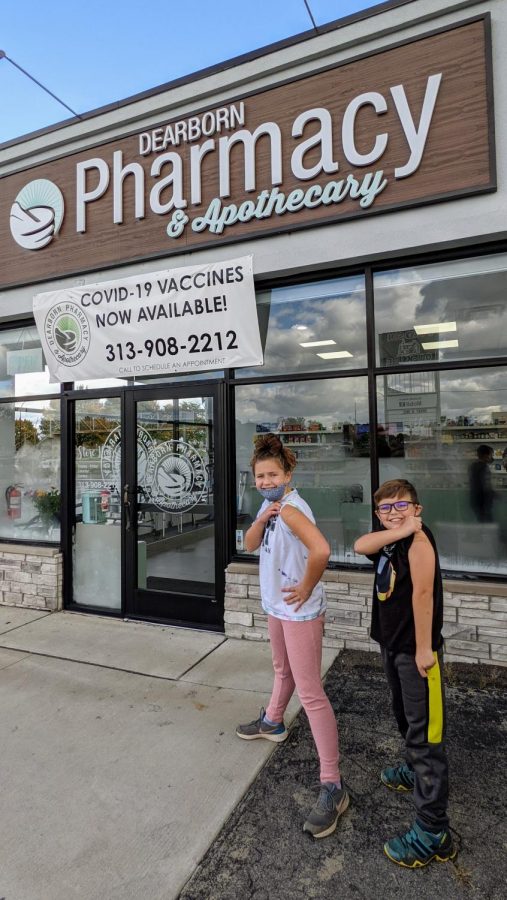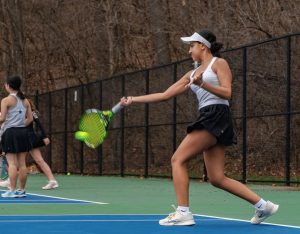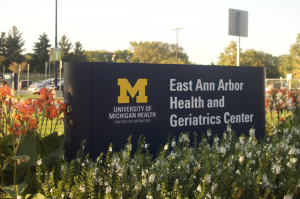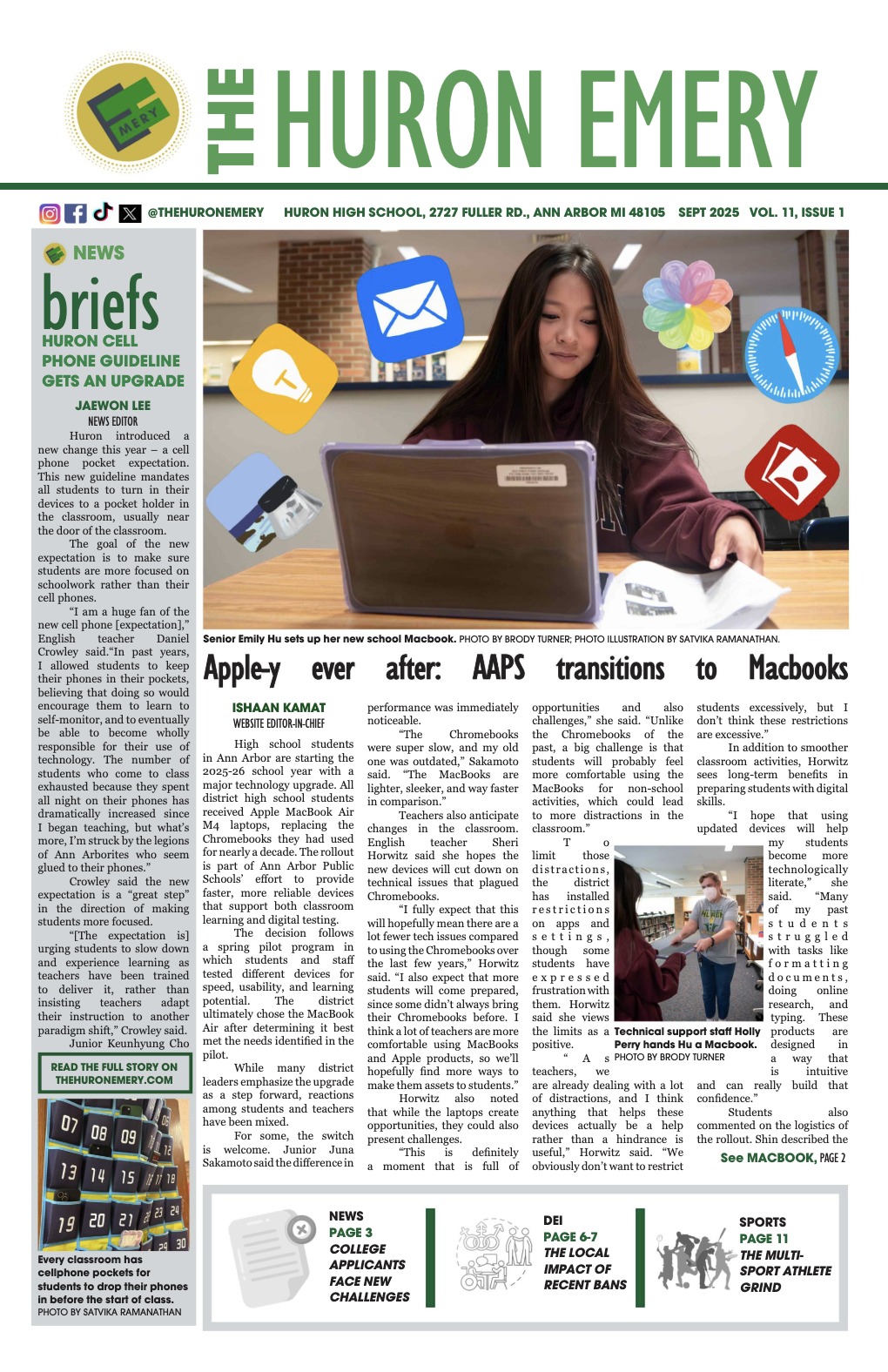FDA authorizes the PfizerBioNTech vaccine for children 5-11 years old
Luke (8) and Sydney (10) showing off their bandaids outside the pharmacy after getting vaccinated.
November 6, 2021
English teacher Sarah Anton cried while watching her kids Luke (8) and Sydney (10) get vaccinated.
“ I think they know that it’s a step to you know, this all being behind us,” Anton said. “You want to see? Anton asks as she is just about to pull out her android phone. I have a picture of them. Of course I do. I’m that mom.”
Anton starts showing a picture.
“So there’s Sydney getting hers and there’s Luke in a Daft Punk shirt of course.”
And another one.
“There they are with their vaccine cards and there they are with their bandaids.”
And wait just one more.
“I’m telling you it was a whole day. It was a whole day,” Anton said in a chipper yet passionate voice.
On Oct. 29, the Food and Drug Administration (FDA) approved the Pfizer-BioNTech Vaccine for emergency use in children 5-11 years of age.
COVID-19 is one of the top ten leading causes of death for children 5-11 years old, and according to the CDC 1.7 percent of deaths among this age group have died of COVID-19.
On Nov. 1 a stakeholder call — with frontline workers — took place with Acting FDA commissioner, Janet Woodcock, and the director of FDA’s Center for Biologics Evaluation and Research, Peter Marks to discuss the authorization that took place.
“At the FDA we’re committed to making decisions that are guided by science that people can trust,” Marks said. “Authorizing the Pfizer BioNTech COVID-19 vaccine for Children 5-11 years of age marks another important step in our collective efforts to bring the COVID-19 pandemic to a close. We know that working together will succeed in this goal.
Sydney and Luke knew how important it was and Anton had talked about the vaccine with them for the longest time and about COVID-19, since March 2020.
“When we first shut down at the time we didn’t know it wasn’t really surface related,” Anton said. “It’s spread through the air and it’s spread on surfaces. So it’s important to have good hygiene and wash our hands and wear our masks and you know at that time we pretty much just stay at home. As time went on, we talked to them like I remember that first summer where it was like okay, we can be outside with friends but we’re still gonna wear our masks and we’re still gonna distance.”
Independent experts and the FDA’s advisory team “overwhelmingly voted” in making the vaccine available for the 5-11 age group.
“Now as a mother and a physician, I know parents, caregivers, school staff and children have been waiting for this authorization,” Woodcock said. “Vaccinating younger children against COVID-19 will bring us closer to returning to a sense of normalcy.”
Woodcock assures the FDA conducted a rigorous and thorough evaluation of the data on the safety and effectiveness of the vaccine and made sure it met their standards..
There was a randomized ongoing placebo-controlled study conducted in the United States, Finland, Poland and Spain used to support the effectiveness data. The FDA was able to analyze the data with 264 participants (5-11 age group) receiving a lower dosage of the vaccine and 253 participants (16-25 age group) receiving the higher dosage.
“The immune responses of the younger age participants were comparable to the older participants,” Marks said. “The FDA also conducted a preliminary analysis of cases of COVID-19 in participants 5-11 years old occurring 7 days after the second dose.”
Of this analysis, three COVID-19 cases from the 1305 participants who received the vaccine and 16 cases among those who received the placebo. According to Marks, this measures the vaccine to be 90.7 percent effective in preventing COVID-19.
For evaluating the safety of the vaccine, the FDA studied a trial with over 4600 (5-11 age group) participants. 3100 received the vaccine and 1538 received the placebo (saline).
The most common side effects reported from the trial recipients were headache, muscle/joint pain, redness at the injection site or pain, swelling, chills, nausea, swollen lymph nodes and fever.
“Most children reported side effects after the second dose,” Marks said. “And more reported side effects after the second dose than after the first dose. The side effects were generally mild to moderate in severity and occurred within two days after vaccination and most went away within one to two days.”
When Anton received the second dose of her vaccine Luke and Sydney observed that she wasn’t feeling good.
“What’s that about?” they questioned and asked.
“This is my body’s immune response,” Anton responded. “It’s getting ready to fight the virus. And that’s why this vaccine is important.”
The FDA also authorized using a different buffer (maintains the vaccine’s pH) in the vaccine’s formulation, known as the TRIS buffer.
“This formulation is more stable at refrigerated temperature for longer periods of time permitting greater flexibility for vaccination providers such as being able to keep it in doctor’s offices,” Marks said.
The TRIS buffer has been used in other FDA-authorized vaccines and products used in children. It does not affect the safety or effectiveness of the vaccine.
“Monitoring the safety of all vaccines is a top priority for the FDA,” Marks said. “Together with CDC we have several systems in place to continually monitor COVID-19 vaccine safety and allow for the rapid detection and investigation of potential safety problems and those systems include the vaccine adverse event reporting system (VAERS).”
VAERS analyzes information, records any effects of vaccination and is a “CDC text-based system.” Another system, the Biological Effectiveness and Safety System investigates any safety signals issued by VAERS. It also makes comparisons with unvaccinated individuals.
“Our actions plus CDC’s recommendations help us get closer to closing another chapter in this pandemic,” Woodcock said. “Vaccines are one of our strongest tools in this fight against this pandemic. And making sure younger children in our population now have access to them has been one of our highest priorities.”
With the Pfizer-BioNTech vaccine myocarditis (when the middle layer of the heart thickens and is caused mainly by infections in the body) is a risk.
“The actual risk in this age group is not totally clear yet,” Woodcock said. “Because it is a rare side effect and we don’t know. What we saw in the adolescents was the peak was toward the earlier adolescents and it seems to be a slightly lower incidence as you go down toward 12.”
Marks adds on and says that there is a significant risk of myocarditis in all age groups and 1 in 5000. These were cases of mild myocarditis that lasted about a day and were rapidly resolved.
“The hope is that in these 5-11-year-olds,” Marks said. “ The dose of the vaccine has been backed off to 10 micrograms. If you look at the comparability of the immune response it’s almost 1:1. SO the hope would be that the risk of myocarditis in this age group will be minimized and is something we will be looking for.”
With the clinical trial, there were no cases of myocarditis and Mark says it won’t be a common side effect.
“The benefits of the vaccine are potentially quite significant in, you know, reducing the risk of the various adverse effects with COVID-19, including myocarditis from COVID-19, the multisystem inflammatory syndrome and the need for hospitalizations so all of those things are potential benefits. We can’t exactly quantify is the peace of mind for allowing the child to be able to socialize more normally and participate in events with family and others which is something that often goes unsaid, but it’s really important to be able to get back to now after we’ve been doing a thing for 21-22 months.”
After witnessing their mom, dad, and all their other family members get vaccinated Luke and Sydney saw the relief in their parents’ eyes.
“ They were ready to put this behind them and they were ready to move on with our lives,” Anton said. They understood that we evaluated the risks and we talked about how we felt it was safe and that the science was good.“They were excited. I don’t think that they are normally excited to get vaccines or flu shots or things like that. They were very brave and I’m so proud of them.”
To look for COVID-19 vaccination sites visit: https://www.vaccines.gov/










